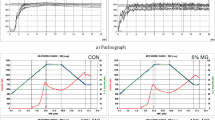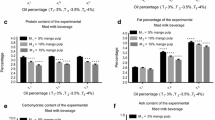Abstract
The present study investigated the effect of processing on the nutritional, functional, organoleptic and rheological properties of millet and sprouted legumes beverage flavored with jaggery (B1) and buttermilk (B2) for its processing suitability. The millets, sprouted legumes, flavoured with jaggery (B1); and buttermilk and salt (B2), used influenced the suspension stability, nutritional, sensory quality and rheology of beverages. Millets imparted minerals and starch while sprouted legumes improved solubility and extractability of nutrients and also increased the levels of anti-oxidants and flavonoids. Buttermilk improved the stability, increased contents of proteins and minerals and imparted a light colour to the beverage. Jaggery was responsible for caramelized colour and flavor, improved consistency, psuedoplasticity and better organoleptic acceptability. The nutritional quality of B2 was higher in terms of iron (1.8 mg/100 g) and calcium (75 mg/100 g) with 90% antioxidant activity. Highest L* values were obtained for B2 indicating lighter color, whereas B1 was darker with lower L* values. Organoleptic evaluation showed higher acceptability (7.6) of B1 as compared to B2. Results of flow behavior indicated pseudo-plastic nature of beverages. Significant increase in viscosity was also observed with the increase in temperature (10, 25 and 45 °C) of the beverages. The flow curves of B1 produced the best fit applying the Power law model and for B2, Casson model was the best fit. Results of this study could be used in improvement of the process for making millet-based beverage, design of packaging system and also to predict the flow behavior of beverages during storage.


Similar content being viewed by others
References
Agbor GA, Moumbegna P, Oluwasola EO, Nwosu LU, Njoku RC, Kanu S, Abudei FA (2011) Antioxidant capacity of some plants foods and beverages consumed in the eastern region of Nigeria. Afr J Trad Complement Altern Med 8(4):362–369
Agrahar-Murugkar D, Jha K (2009) Effect of sprouting on nutritional and functional characteristics of soybean (Glycine max L). J Food Sci Technol 46(3):240–243
Agrahar-Murugkar D, Jha K (2010) Effect of drying on the nutritional and functional quality and electrophoretic pattern of soy flour from sprouted soybean (Glycine max). J Food Sci Technol 47(5):482–483
Agrahar-Murugkar D, Gulati P, Kotwaliwale N, Gupta C (2015) Evaluation of nutritional, textural and particle size characteristics of dough and biscuits made from composite flours containing sprouted and malted ingredients. J Food Sci Technol 52(8):5129–5137
AOAC (2005) Method 920.87. Official methods of analysis. Association of Official Analytical Chemists, 14th edn. AOAC, Arlington
Bhattacharya S, Vasudha N, Krishna Murthy KS (1999) Rheology of mustard paste: a controlled stress measurement. J Food Eng 41(3):187–191
Cano-Ruiz ME, Richter RL (1998) Changes in physicochemical properties of retort-sterilized dairy beverages during storage. J Dairy Sci 81(8):2116–2123
Conway V, Couture P, Richard C, Gauthier SF, Pouliot Y, Lamarche B (2013) Impact of buttermilk consumption on plasma lipids and surrogate markers of cholesterol homeostasis in men and women. Nutr Metab Cardiovasc Dis 23(12):1255–1262
Conway V, Gauthier SF, Poulio Y (2014) Buttermilk: much more than a source of milk phospholipids. Anim Front 4(2):44–51
Ferguson J, Kembłowski Z (1991) Applied fluid rheology. Elsevier, Barking
Fuller KL, Kuhlenschmidt TB, Kuhlenschmidt MS, Jiménez-Flores R, Donovan SM (2013) Milk fat globule membrane isolated from buttermilk or whey cream and their lipid components inhibit infectivity of rotavirus in vitro. J Dairy Sci 96(6):3488–3497
Gurr MI (1987) Nutritional aspects of fermented milk products. FEMS Microbiol Lett 46(3):337–342
Janhøj T, Frøst MB, Ipsen RH (2008) Sensory and rheological characterization of acidified milk drinks. Food Hydrocoll 22(5):798–806
Kiranmai M, Kumar CM, Ibrahim M (2011) Comparison of total flavanoid content of Azadirachta indica root bark extracts prepared by different methods of extraction. Res J Pharmacoll Biol Chem Sci 2:254–261
Kolapo AL, Olubamiwa AO (2012) Effect of different concentrations of coconut milk on the chemical and sensory properties of soy-coconut milk based yoghurt. Food Public Health 2(4):85–91
Kristensen D, Jensen PY, Madsen F, Birdi KS (1997) Rheology and surface tension of selected processed dairy fluids: influence of temperature. J Dairy Sci 80(10):2282–2290
Lee SE, Hwang HJ, Ha JS, Jeong H, Kim JH (2003) Screening of medicinal plant extracts for antioxidant activity. Life Sci 73:167–179
McGuire RG (1992) Reporting of objective color measurements. Horti Sci 27:1254–1255
Nunes MHB, Moore MM, Ryan LA, Arendt EK (2009) Impact of emulsifiers on the quality and rheological properties of gluten free breads and batters. Eur Food Res Technol 228:633–642
Penna ALB, Sivieri K, Oliveira MN (2001) Relation between quality and rheological properties of lactic beverages. J Food Eng 49(1):7–13
Phillips LG, McGrift ML, Barbano DM, Lawless HA (1995) The influence of fat on the sensory properties, viscosity and color of low-fat milk. J Dairy Sci 78:1258–1266
Pintea AM (2008) Food colorants derived from natural sources by processing. In: Socaciu C (ed) Food colorants: chemical and functional properties. CRC Press, Florida, pp 329–346
Priepke PE, Wei LS, Nelson LS, Steinberg MP (1980) Suspension stability of Illinois soybean beverage. J Food Sci 45:242–245
Ramaswamy L (2014) Coconut flour: a low carbohydrate, gluten free flour. Int J Ayur Herb Med 4:1426–1436
Rao MA (2014) Flow and functional models for rheological properties of fluid foods. In: Barbosa-Canovas GV (ed) Rheology of fluid, semisolid, and solid foods, food engineering series, 3rd edn. CRC Press, New York, pp 27–57
Singh RP, Heldman DR (2009) Introduction to food engineering, 4th edn. Elsevier, USA
Singleton VL, Rossi JA (1965) Colorimetry of total phenolics with phosphomolybdic-phosphotungstic acid reagents. Am J Enol Vitic 16:144–158
Siwela M, Taylor JR, de Milliano WA, Duodu KG (2010) Influence of phenolics in finger millet on grain and malt fungal load, and malt quality. Food Chem 121:443–449
Sopade PA, Kiaka K (2001) Rheology and microstructure of sago starch from Papua New Guinea. J Food Eng 50:47–57
Thapa S, Tamang JP (2004) Product characterization of Kodo ko Jaanr: fermented finger millet beverage of the Himalayas. Food Microbiol 21(5):617–622
Tizazu S, Urga K, Abuye C, Retta N (2010) Improvement of energy and nutrient density of sorghum-based complementary foods using germination. Afr J Food Agric Nutr Dev 10(8):2927–2942
Vitali AA, Rao MA (1984) Flow properties of low-pulp concentrated orange juice: effect of temperature and concentration. J Food Sci 49(3):882–888
Wadikar DD, Premvalli RS, Satyanarayanswamy YS, Bawa AS (2007) Lipid profile in finger-millet. J Food Sci Technol 44(1):79–81
Wong PYY, Kitts DD (2003) Chemistry of buttermilk solid antioxidant activity. J Daiiry Sci 86(5):1541–1547
Yolacaner E, Sumnu G, Sahin S (2008) Rheological properties and quality of rice cakes formulated with different gums and an emulsifier blend. Food Hydrocolloids 22(2):305–312
Author information
Authors and Affiliations
Corresponding author
Additional information
Publisher's Note
Springer Nature remains neutral with regard to jurisdictional claims in published maps and institutional affiliations.
Rights and permissions
About this article
Cite this article
Agrahar-Murugkar, D., Bajpai-Dixit, P. & Kotwaliwale, N. Rheological, nutritional, functional and sensory properties of millets and sprouted legume based beverages. J Food Sci Technol 57, 1671–1679 (2020). https://doi.org/10.1007/s13197-019-04200-y
Revised:
Accepted:
Published:
Issue Date:
DOI: https://doi.org/10.1007/s13197-019-04200-y




